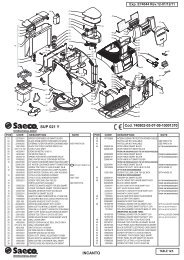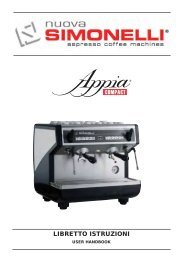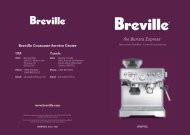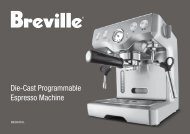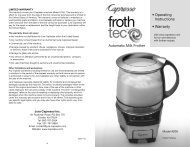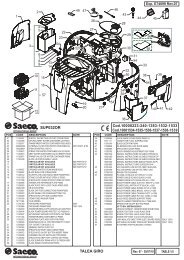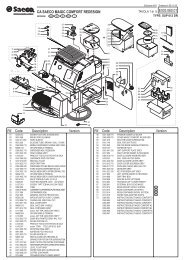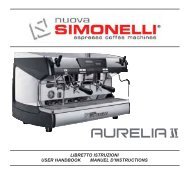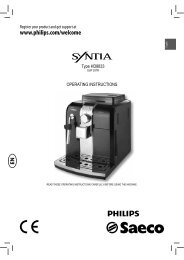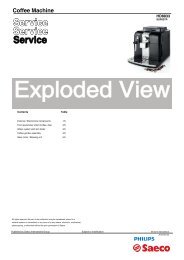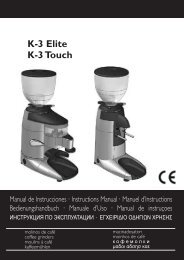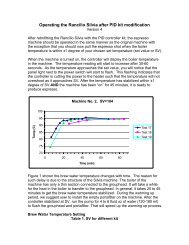USB / S / RE - Seattle Coffee Gear
USB / S / RE - Seattle Coffee Gear
USB / S / RE - Seattle Coffee Gear
Create successful ePaper yourself
Turn your PDF publications into a flip-book with our unique Google optimized e-Paper software.
6.1.2. Electric supply<br />
The machine is supplied ready for connection<br />
according to the required electrical specifications.<br />
Before connecting the machine ensure that the plate<br />
details comply with those of the electric distribution<br />
network.<br />
The electrical connection cable must be directly<br />
connected to the connection provided according to<br />
current legislation. Ensure that the earthing system<br />
is efficient and in compliance with current legal requirements.<br />
The earthing system and the lightening protection<br />
system must be realized in accordance with the<br />
provisions of current legislation.<br />
For the supply network use a cable in compliance with<br />
standards with protective conductor (earthing wire).<br />
For three-phase power use a cable with 5 conductors<br />
( 3 phases + neutral + earth).<br />
For single phase power supply use a cable with 3<br />
conductors (phase + neutral + earth).<br />
In both cases it is necessary to provide an automatic<br />
differential switch (Fig. 6) at the start of the power<br />
cable, complete with magnetic release elements in<br />
accordance with the identification plate details (Fig.<br />
1). The contacts must have an opening of equal or<br />
over 3 mm and with dispersed current protection of<br />
30 mA.<br />
Remember that each machine must be fitted with its<br />
own safety elements.<br />
WARNING:<br />
Should the power supply cable be damaged<br />
it is to be replaced by the manufacturer or by<br />
its technical assistance service or by person<br />
with equivalent qualification, in order to prevent<br />
any risks.<br />
6.3. CONNECTIONS<br />
Place the machine on the horizontal surface previously<br />
prepared.<br />
Before connecting, thoroughly wash the mains water<br />
pipes:<br />
Leave the water supply taps running at full pressure<br />
for several minutes.<br />
Connect to the mains water supply.<br />
Connect the machine to the socket.<br />
Connect the gas pipe<br />
Thoroughly wash all the water pipes of the machine:<br />
Leave the water supply taps running at full pressure.<br />
Switch on main switch 1 (Fig.8): wait until the boiler<br />
fills up to the level set.<br />
Boiler resistance switch2 (Fig.8) to begin heating<br />
the water in the boiler.<br />
Operate each unit in order to allow the water to<br />
escape for about one minute; repeat the operation<br />
twice.<br />
Deliver steam from the steam jets for about one<br />
minute.<br />
Deliver hot water for about one minute; repeat the<br />
operation twice.<br />
Switch off switches 1 and 2.<br />
Empty the water from the boiler: see point 10.3.<br />
IMPORTANT<br />
Should the machine not deliver water for over<br />
24 hours, wash the internal components before<br />
beginning work, repeating the operations<br />
as described above.<br />
6.2. Preliminary operations (Fig.7)<br />
P O T E N T I A L - E Q U A L I Z I N G<br />
CONNECTION<br />
This connection, which is the one called for by several<br />
norms, avoids electrical potential differences, building<br />
up between any equipment that may be installed in<br />
the same room. There is a terminal clip on the under<br />
side of the base of the machine to which an external<br />
potential-equalizing wire should be connected.<br />
This connection is ABSOLUTELY NECESSARY and<br />
must be made right after the machine is installed.<br />
Use a wire whose cross-sectional area conforms to<br />
the existing norms.<br />
74




